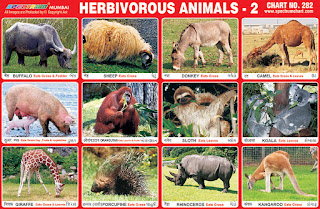Buffalo - Buffaloes are used in farming for
ploughing, tilling rice fields etc. Buffalo milk is processed into a
large variety of dairy products. The bones and horns are often made
into jewellery. Horns are used for the embouchure of musical
instruments, such as ney and kaval.
Sheep - Sheep are
medium-sized herbivorous animal. Sheep are mainly farmed for their
meat and wool but sheep are also occasionally farmed for their milk.
Sheep's wool is the most widely used animal fibre.
Donkey - Donkey is known as a working animal.
After human labour, the donkey is the cheapest form of agricultural
power. Donkeys are used to be ridden, used for threshing, raising
water, milling and other work. Donkey is a herbivore. Its diet is
based on grass and grains. Donkey has excellent memory and ability to
recognise other donkeys & people.
Camel - Camel is known as a
'Ship of desert.' They are mostly found in deserts & dry
regions. Camels have been used by people for transporting goods &
people across the desert and also for its milk and meat. Camel can
survive without food & water long period of time.
Pig - Pigs are highly
social and intelligent animals. Pigs are raised commercially for
meat generally called pork, hams, gammon or bacon, as well as for
leather. Their bristly hairs are also used for brushes.
Orangutan - Orangutans are
large, red coloured Apes. They are the only group of Great Apes that
live outside the Africa. There are two types of orangutans: Sumatran
and Borean orangutans. Both species are critically endangered
because of poaching and loss of habitat. Orangutans are the largest
arboreal mammals. They are herbivore. 50% of their diet consists of
fruit.
Sloth - Sloth is a medium
sized animal. It is usually 2 to 2.5 feet long. Sloths have round
face, sad eyes, small ears and short tail. Their body is covered
with wiry fur. Fur of the sloth can be black, brown or grey. Sloth
is herbivore & usually spends 20 hours per day in sleeping.
Sloth is arboreal (lives in the trees) creature.
Koala - Koalas are native
to Australia and live in eucalyptus forests. They have poor
eyesight, but excellent sense of smell, which helps them find type
of eucalyptus they like to eat. Koalas spend most of their time in
trees. They sleep 16-18 hours per day. They are nocturnal animals.
Giraffe - Giraffes are the
tallest living animals in the world. A fully grown up giraffe is 14
feet tall & weighs up to 680 kg. A giraffe's habitat is usually
found in African savannas, grasslands or open woodlands. Giraffe is
a herbivore. Favourite food of giraffes is acacia. They also like
leaves of mimosa and apricots.
Lifespan of giraffe ranges between 20- 25 years.
Porcupine - Porcupines are
rodents. They live in America, Africa, Europe and Asia. Body of the
porcupine is covered with sharp spines or quills. Porcupines can't
shoot out their quills, but they will be easily released when
predators get it touch with animal. Porcupines are nocturnal
animals. They are herbivorous animals. They like to eat leaves,
stem, bark, fruit.
Rhinoceros - Rhinoceros
means ‘nose horn.’ Rhinoceros averages about 1.5 tons in weight
& have thick, protective skin that is roughly 1.5 cm thick.
Rhinoceros are often hunted by humans for their horns. Rhinos are
herbivorous animals. They eat grass, shrubs, leaves and shoots.
Rhinoceros have the lifespan of about 35 to 50 years.
Kangaroo - Kangaroos are
marsupial animals that are found in Australia as well as New Guinea.
They have a deep pouch on their front in which they carry their
young ones. Red kangaroo is the largest marsupial in the world.
Kangaroos are herbivores. They eat grass, shrubs, shoots and tree
leaves. Their lifespan is 4 to 10 years.


No comments:
Post a Comment